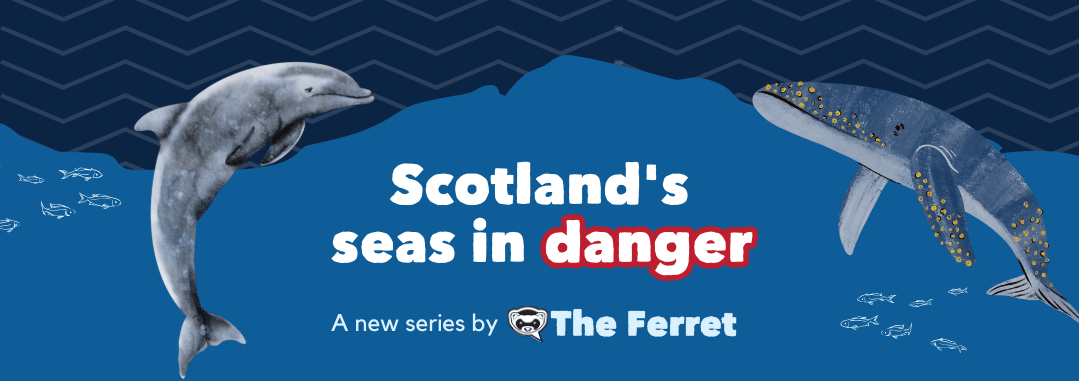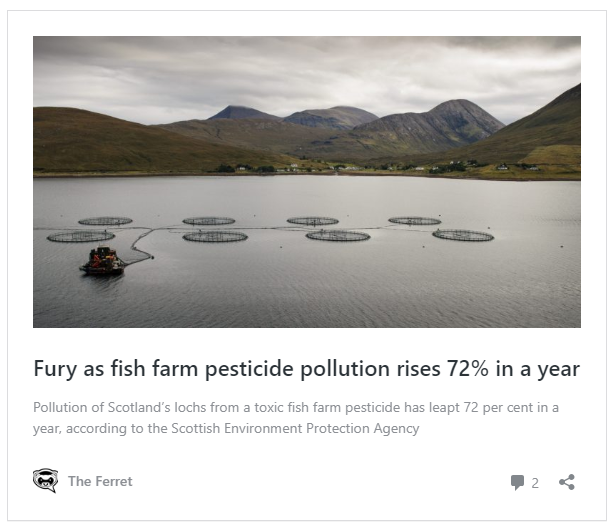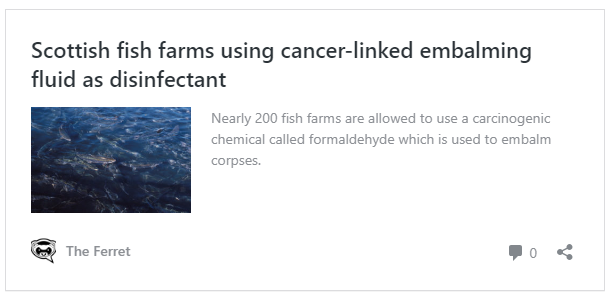A toxic pesticide that causes cancer was used by fish farms nearly 200 times over a three year period, despite fears the chemical could harm the marine environment.
Formaldehyde, which is used in mortuaries to embalm bodies, is also used by fish farmers to control fungus, parasites and diseases that affect salmon.
New data released by Sepa after a freedom of information (FOI) request by the campaigner Don Staniford, reveals that formaldehyde was used 194 times between January 2020 and June 2023.
The FOI reply also revealed the number of fish farms reporting the use of formaldehyde to Sepa had increased from four in 2017 to 16 by 2023.
The farmed salmon industry said the chemical – famously used by artist Damien Hirst to preserve dead cows and sharks – breaks down quickly in water and is safe for the environment.
Critics, however, said they are “deeply concerned” about the increase in the number of fish farms “using this carcinogenic chemical”, and that the “dumping of toxic chemicals into the sea and freshwater lochs” should be banned.
Our report on formaldehyde forms part of The Ferret’s new series on the marine environment called Scotland’s Seas In Danger.

The use of formaldehyde by fish farms was revealed by The Ferret in 2019 when we found that 184 sites in Scotland were allowed to use the chemical. A year later we revealed that ten lochs had been polluted by formaldehyde.
To disinfect fish, farmers use a solution called formalin. Formalin contains formaldehyde and although it is legal to use, there are concerns over its safety. The fish farm industry insists formalin is used safely and legally at all times.
The UK government classified formaldehyde as a carcinogen in 2016 which means there are restrictions on its use. The Scottish Environment Protection Agency (Sepa), which authorises its use in Scotland, says that uncontrolled releases have the potential to cause significant harm to the environment.
Sepa’s data does not include details of formaldehyde used by all fish farms. Some firms only report usage to the Scottish Government’s Fish Health Inspectorate prompting claims Sepa is failing to monitor the chemical properly.
In total, we found that 36 fish farms have reported using formaldehyde.
Norwegian giant Mowi is by far the largest user of formaldehyde with 100 tonnes released, the data shows. Mowi’s Loch Lochy salmon farm, near Fort William, has used over 40 tonnes of the chemical.
Other companies using formaldehyde include Kames, Bakkafrost, and Cooke Aquaculture.
Scotland’s freshwater lochs should be for wildlife and for the public to enjoy, not waste disposal facilities for Norwegian salmon feedlots where we have to worry if our kids will come into contact with cancer causing chemicals.
Corin Smith, fish farm campaigner.
In 2018 in India, there was a scare over preserved fish laced with formalin, prompting a ban on fish imports in Goa state. There is no evidence of Scottish salmon being similarly contaminated.
Guidance from the UK Department for Environment Food and Rural Affairs on formalin says: “Fish, poultry, sheep and cattle farmers – as professionals – will be able to continue to use products containing formaldehyde for dis-infection, fumigation and foot bathing purposes.
“However if a health and safety issue arose through its use and be (sic) investigated, and the person using it found not to have been suitably trained and competent, then there could be grounds for prosecution.”
Other pesticides used by Scottish fish farmers include azamethiphos, a chemical known to kill marine wildlife, and emamectin, which poses a danger to crabs, lobsters and other crustaceans. In 2020, The Ferret reported that pollution of Scotland’s lochs by the former had leapt by 72 per cent in a year, prompting criticism by campaigners.
Azamethiphos and emamectin have been widely used for years by salmon and trout farmers to kill the sea lice that can plague farmed fish. They replaced a series of previous pesticides, which were either banned or became ineffective in the 1990s.
At the time of our previous report the salmon farming industry stressed that pesticide pollution was less in 2019 than it had been in preceding years.

Don Staniford, director of campaign group Scottish Scamon, called for a public register of fish farms using formaldehyde and an “immediate ban” on its use. He said companies failing to report the use of toxic chemicals should be fined and lose their operating licence. “Salmon farming is the real monster in the loch of Scotland,” Staniford added.
The Scottish Greens MSP Ariane Burgess said she was “deeply concerned” over the increased use of formaldehyde, and pointed out that over 10,000 people signed a petition in 2021 asking for a ban on its use in freshwater lochs until a public consultation on its safety took place.
She told The Ferret: “That consultation did not happen. In the same year, the charity Fidra called for more transparency and control over the use of this toxic chemical. This also has not happened.”
Burgess added: “I would hope that Sepa have this in their work plan, especially given the Scottish Government’s vision for sustainable aquaculture states a need to, ‘minimise, reduce or remove the discharge of medicine residues and increase the use of effective non-medicinal treatments, waste recovery and preventative measures’. With formaldehyde, the industry appears to be going in the opposite direction.”
John Atchison, from the marine conservation group Coastal Communities Network (CCN), said “no other industry is allowed to pollute Scotland’s waters to the same extent”. Sepa, he said, must “get a grip on the routine dumping of toxic fish farm chemicals” into the sea and freshwater lochs.
“It is outrageous that Sepa’s figures for fish farm discharges of formalin do not tally with the Fish Health Inspectorate’s figures,” he added. “This is a really unpleasant chemical but there seems to be no proper regulation of its use. For years Coastal Communities Network and others have been urging Sepa to tighten its rules but the situation just seems to keep getting worse.”
Salmon farming is the real monster in the loch of Scotland.
Don Staniford
Dr Iain Berrill, head of technical at Salmon Scotland – which represents Scotland’s farmed salmon sector – said formalin is a licenced veterinary medicine that is used to “effectively treat infections that are sometimes experienced during the freshwater phase of salmon farming”.
He added that formalin is used in accordance with “strict veterinary and environmental regulations”, including from the UK Veterinary Medicines Directorate and Sepa. “These regulations ensure that any use of formalin is safe for the public, salmon farmers, our farm-raised salmon and for the environment,” Berrill continued.
“It is worth noting that formalin is widely available for purchase by the general public and is used extensively by a range of sectors. For example, about four million tonnes of formalin is produced in the EU each year. The volumes used by salmon farmers are a tiny percentage of the volumes used within the UK and elsewhere.”
Ben Hadfield, COO Mowi Scotland, said: “This continued focus from anti-salmon farming campaigners and an isolated politician about formaldehyde use in aquaculture seems misguided and quite bizarre, given it quickly breaks down to natural levels found in the decay of organic matter like leaves and wood and is present in the sediment of lochs with or without salmon farms.
He added: “This activist noise is simply fearmongering, with no scientific basis and no cause for any concern. In fact, the sustainability of raising smolt in freshwater lochs is very high, demonstrated by our company’s top ranking in global protein producer indexes and by achieving sustainability certification founded by the World Wildlife Fund.”

Peter Pollard, head of ecology at the Scottish Environment Protection Agency (Sepa), said it “routinely carries out audits of farms” to ensure compliance and that “all operators are required to log medicine use for audit purposes”.
He added: “Whilst some legacy authorisations require only that (medicine) logs are maintained for audit purposes, Sepa will be progressively standardising authorisations over the coming years to ensure consistent reporting requirements.”
Pollard also pointed out that across Scotland, livestock farmers, including fish farmers, “rely on effective access to animal medicines”. He said formaldehyde is used to treat a range of conditions in freshwater farms and facilities.
“Its use is controlled and authorised by Sepa, with limit conditions on medicine quantities that can be discharged into the water environment,” he continued. “The limits are set to ensure discharges to levels that receiving rivers and freshwater lochs can accommodate without compromising environmental quality standards.”
A spokesperson for the Scottish Government said: “Fish farming is a highly regulated sector with robust environmental and fish health controls in place. The use of formaldehyde is strictly regulated by the independent Scottish Environment Protection Agency. It can be safely used in fish farming and, as regulated, it does not pose a risk to food safety.”
Cooke Aquaculture declined to comment and referred us to Salmon Scotland to comment “on behalf of the sector”.
Kames and Bakkafrost did not reply to our requests for a comment.
This story was updated at 09.56 on 22 February 2024 to include this paragraph following a complaint by Salmon Scotland: “To disinfect fish, farmers use a solution called formalin. Formalin contains formaldehyde and although it is legal to use, there are concerns over its safety. The fish farm industry insists formalin is used safely and legally at all times.
This story was updated at 09.16 on 6 March 2024. The headline was changed to “Formaldehyde used 200 times by fish farm industry”, and the following paragraph was inserted: “There is no evidence of Scottish salmon being similarly contaminated.” We aslo deleted these words from the first paragraph: “and endanger human health.”
This Ferret story was also published in the Sunday National. Our partnerships with other media help us reach new audiences and become more sustainable as a media co-op. Join us to read all our stories and tell us what we should investigate next.
Scotland’s Seas in Danger is a year-long investigative series by The Ferret that delves into Scotland’s marine environment. Our investigations were carried out with the support of Journalismfund Europe.

This project is was conducted in partnership with the Investigative Reporting Project Italy (IRPI), which will publish its work later this year.
If you like what we do and want to help us do more independent journalism, you can support us by becoming a member. You can also donate or subscribe to our free newsletter.
Main image: Jakub Rutkiewicz/iStock














